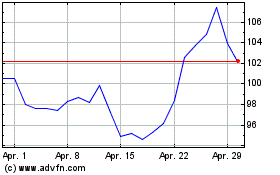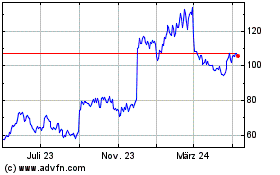Elastic Announces New Capabilities to Help Customers Defend Against Cyber Attacks and Accelerate App Development
08 März 2022 - 10:13PM
Business Wire
Introducing Expanded Data Integrations, Faster
Indexing Speeds, and More Efficient Storage Utilization
- Introducing new prebuilt detections and data source
integrations to help customers protect against advanced cyber
threats
- Providing deeper visibility into AWS Lambda and CI/CD pipelines
to further accelerate software development lifecycles
- Delivering faster time to insights while increasing storage
efficiency with doc-value-only fields
Elastic (NYSE: ESTC) (“Elastic”), the company behind
Elasticsearch, today announced enhancements across the Elastic
Search Platform and its solutions. New enhancements enable
customers to stop advanced cyber threats with new prebuilt
detections and data source integrations, and accelerate application
development with deeper visibility into serverless architectures
and continuous integration and continuous delivery (CI/CD)
pipelines.
Preventing sophisticated cyber attacks and extending
visibility across organizations
New prebuilt detections and host-based malicious behavior
protections, both generally available, automate protection against
sophisticated attacks, such as Log4j and the Blister malware
campaign, to help customers streamline security investigations and
mitigate risk without diminishing visibility.
Customers can also now leverage Elastic Agent to collect and
normalize network activity from an unlimited number of Windows,
macOS, and Linux systems, helping security practitioners monitor
for suspicious activity and gather valuable forensic insights
within and beyond the network perimeter.
In addition, Elastic added new data source integrations with
Recorded Future, ThreatQuotient ThreatQ, and Cybersixgill to
streamline the ingestion of threat intelligence and help analysts
automate detections, improve prioritization, and accelerate threat
analysis.
Accelerating application development with deeper visibility
into AWS Lambda and CI/CD pipelines
With enhanced end-to-end application performance monitoring
visibility, customers can now collect traces from AWS Lambda, in
beta, and correlate those traces with other Elastic Observability
data—including from CI/CD environments—for faster and more
comprehensive root cause analysis.
Additionally, support for OpenTelemetry logs, also in beta,
enables organizations that use OpenTelemetry for traces and metrics
to standardize data collection across all data types. The ability
to ingest OpenTelemetry logs provides customers an opportunity to
deploy a standardized, vendor-neutral observability architecture
without losing correlation between signal types and layers.
Delivering faster time to insights and improved storage
efficiency
Now generally available, the ability to enable doc-value-only
fields gives customers the flexibility to index data faster while
improving storage efficiency. With this new capability, customers
can benefit from up to 20% faster indexing speeds and 20% lower
data storage requirements, ultimately helping them accelerate time
to insights while balancing cost and performance.
Customers can also leverage several new ad hoc analytics
capabilities in Kibana Lens to enhance data exploration, including
three new visualization types—gauge, waffle, and mosaic—and a new
drag-and-drop capability to combine and compare multiple
fields.
For more information read the Elastic blog about what’s new in
Elastic 8.1.
Supporting Quotes:
- “The technology behind Citadel Group’s go-to-market strategy,
and our drive to expand globally, significantly leverages Elastic’s
Observability and Security solutions,” said Mark McConnell, CEO
and Managing Director, The Citadel Group. “Elastic Security is
crucial for the SecOps team to function properly and fulfill its
role of protecting Citadel and its customers from cyber threats.
Elastic Observability capabilities are crucial for us to provide
quality managed services to our customers.”
- “As data volumes continue to grow and become more dispersed,
cyber threats continue to rise,” said Santosh Krishnan, General
Manager of Elastic Security, Elastic. “As the world’s leading
platform for search-powered solutions, Elastic offers faster
indexing speeds, new prebuilt detections, and even more data source
integrations to help analysts automate detection, improve
prioritization, and accelerate threat analysis. These enhanced
capabilities extend user visibility across digital
ecosystems—including serverless architectures—and protect against
advanced adversaries, while giving customers the flexibility to
balance cost and performance.”
About Elastic:
Elastic is a search company built on a free and open heritage.
Anyone can use Elastic products and solutions to get started
quickly and frictionlessly. Elastic offers three solutions for
enterprise search, observability, and security, built on one
technology stack that can be deployed anywhere. From finding
documents to monitoring infrastructure to hunting for threats,
Elastic makes data usable in real time and at scale. Thousands of
organizations worldwide, including Cisco, eBay, Goldman Sachs,
Microsoft, The Mayo Clinic, NASA, The New York Times, Wikipedia,
and Verizon, use Elastic to power mission-critical systems. Founded
in 2012, Elastic is a distributed company with Elasticians around
the globe and is publicly traded on the NYSE under the symbol ESTC.
Learn more at elastic.co.
The release and timing of any features or functionality
described in this document remain at Elastic’s sole discretion. Any
features or functionality not currently available may not be
delivered on time or at all.
Elastic and associated marks are trademarks or registered
trademarks of Elastic N.V. and its subsidiaries. All other company
and product names may be trademarks of their respective owners.
View source
version on businesswire.com: https://www.businesswire.com/news/home/20220308006307/en/
Chloe Guillemot Elastic Public Relations PR-Team@elastic.co
Elastic NV (NYSE:ESTC)
Historical Stock Chart
Von Mär 2024 bis Apr 2024

Elastic NV (NYSE:ESTC)
Historical Stock Chart
Von Apr 2023 bis Apr 2024
